#16 October 1813
Explore tagged Tumblr posts
Text




















The Sixth Coalition attacked Napoleon in the three-day Battle of Leipzig on October 16, 1813.
#Sixth Coalition#attacked#Napoleon#Battle of Leipzig#16 October 1813#anniversary#history#Völkerschlachtdenkmal#Bruno Schmitz#Germany#Leipzig#Monument to the Battle of the Nations#tourist attraction#landmark#summer 2020#Saxony#Sachsen#archangel#Michael#original photography#vacation#travel#Deutschland#See der Tränen#pond#reflection#evening light
7 notes
·
View notes
Text
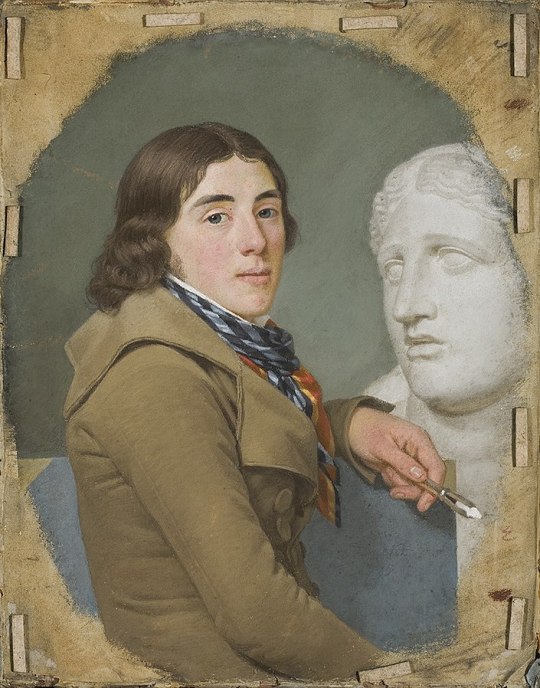
Joseph Octave van der Donckt - Portrait of Albert Gregorius - 1795
Franciscus Joseph Octave van der Donckt (30 June 1757, Aalst - 16 August 1813, Bruges) was a Flemish portrait painter, miniaturist and pastellist. He is also referred to as Jozef Angelus Van der Donckt, as well as several other variations, too numerous to list.
Albert Jacob Frans Gregorius, or Albert Jacques François Grégorius (26 October 1774, Bruges - 25 February 1853, Bruges) was a Flemish-Belgian portrait painter and Director of the art academy in Bruges.
He was born into a poor, laboring family. His drawing abilities were observed by François van der Donckt, a local portrait painter who took him in, gave him his first lessons and helped him enroll at the art academy. Gregorius was there from 1791 to 1793 and won several awards.
In 1801, he went to Paris, where he was apprenticed to Joseph-Benoît Suvée, who was also from Bruges. Not long after, Suvée went to Rome to become Director of the French Academy, but Gregorius was able to find a position in the studios of Jacques-Louis David. In 1805, he was back in Bruges, making preparations to enter the Prix de Rome, but fell ill and was unable to participate.
After his recovery, he returned to Paris and remained until 1835. He soon established a reputation as a portrait painter and formed an association with other expatriate Flemish artists ("De Club van de Belgen"). After exhibiting in the Ghent Salon, he entered the Paris Salon in 1812 and would continue to display there annually until his departure. In addition to the usual French nobility, he is also known for his portrait of August Wilhelm Schlegel, which is now on display at Coppet Castle.
At the age of 61, he received an appointment as Director of "De Vrije Academie" (now "De Stedelijke Academie") in Bruges. He served until 1852, when he was forced to resign after clashes with colleagues, students and city officials over his conservative approach to art. His best-known student was Ford Madox Brown.
Curiously, on his death certificate he was described as a "widower", but his wife's name was unknown. It has been speculated that he was briefly married during his long stay in France and had no close relatives he cared to notify.
#Franciscus Joseph Octave van der Donckt#18th#bruges#portrait#Albert Gregorius#belgium#19th#paris#history
41 notes
·
View notes
Text
Empress Xiaoshencheng of the Qing Dynasty (1822-1833)

Empress Xiaoshencheng was born on 7 May 1792 to a first class duke of the Manchu Bordered Yellow Banner Tunggiya clan. Her personal name was never recorded.
She was chosen to marry Mianning, the future Daoguang Emperor, after the death of his first primary consort and did so in February of 1809. She would give birth to his first daughter, Princess Duanmin of the First Rank, in July of 1813. Unfortunately, her daughter would die just five years later.
After Mianning ascended the throne, Lady Tunggiya would be named Empress Consort and placed in charge of the harem. She would perish 10 years later on 16 June 1833. Empress Tunggiya was only 41 years old.
Titles:
Lady Tunggiya (from July 5 1792)
Primary Consort (from Feb 2 1809)
Empress (from Dec 1822)
Empress Xiaoshen (posthumous fro Sept 7, 1833)
Empress Xiaoshencheng (posthumous from October 1850)
7 notes
·
View notes
Photo

John Adams
John Adams (1735-1826) was an American lawyer, statesman, and diplomat who was a prominent leader of the American Revolution (1765-1789) before going on to serve as the first Vice President (1789-1797) and second President of the United States (1797-1801). He is considered a Founding Father of the United States, having helped lead the push for independence.
Early Life
John Adams was born on 30 October 1735 in Braintree, Massachusetts. His father, John Adams Sr., was a farmer, shoemaker, church deacon, and selectman for the town of Braintree, who was well-liked in his 2,000-person community. The younger John greatly admired his father, later writing of him that "in wisdom, piety, benevolence, and charity��I have never known his superior" (McCullough, 33). John's mother, Susanna Boylston Adams, came from one of the most prominent medical families in New England; her uncle Zabdiel Boylston was the first American physician to perform smallpox inoculations. John had two younger brothers, Peter and Elihu, and spent his childhood "making and sailing boats…swimming, skating, flying kites and shooting marbles…running about to quiltings and frolics and dances among boys and girls". As Adams would later recall, his childhood "went off like a fairytale" (McCullough, 31).
In 1751, at the age of 16, John Adams enrolled in Harvard College with the encouragement of his father, who had hoped that his son would become a minister. Yet, Adams realized he was better suited for a career in law. After graduating from Harvard in 1755, he took a job as a schoolteacher in Worcester, Massachusetts, to sustain himself while he studied law under James Putnam, one of the most prominent lawyers in Worcester. He was admitted to the bar on 6 November 1759 and began practicing law in Braintree and Boston. He lost his first case on a technicality, which temporarily shook his self-confidence, but he continued to dedicate himself to the study of law. By 1762, his practice had taken off, and he was soon riding the circuit of Massachusetts courts with the royal judges.
In 1759, Adams was introduced to 15-year-old Abigail Smith, a shy, delicate-looking girl who had been frequently ill in her childhood. At first, Adams took little interest in Abigail, writing that she and her sisters were neither "fond, nor frank, nor candid" (McCullough, 52). But the pair became closer in the following years, bonding over their shared love of books. In 1761, upon the death of his father, Adams inherited nine acres of land and a farmhouse in Braintree; he and Abigail lived there after their marriage on 25 October 1764. The couple would ultimately have four children who survived childhood: Abigail ‘Nabby' Adams (1765-1813), John Quincy Adams (1767-1848), Charles Adams (1770-1800), and Thomas Boylston Adams (1772-1832). Another daughter, Susanna (b. 1768) died before her second birthday while the couple's final child, Elizabeth, was stillborn in 1777.
Abigail Adams
Benjamin Blyth (Public Domain)
Continue reading...
19 notes
·
View notes
Text

More Than Diamonds
Pairing: Prince Friedrich x Princess! Reader
Description: Britain has gained themselves a new royalty nearing the debutante ball of 1813. Princess Amelia of Siam was sent as the new Ambassador of Siam. In Britain Princess Amelia was able to find her family, but will that be all?
After the failed courting between Daphne and prince Friedrich, it was a surprise to everyone that he stayed in London. However, Prince Friedrich is anything, but a coward. He came to Britain to find a wife and one failed courting will not chase him out of the country with a tail between his legs.
What both Amelia and Friedrich never thought to happen is, the friendship that blossomed between them and their growing feelings for one another.
Friedrich was never a coward, but he is when it comes to Amelia. Everyone said Amelia is a genius, but not when it comes to love, because she is truly lost on what to do with these butterflies in her stomach.
Tags: Slow burn, Coming of age, Time-Travel, Back to the past, Friends to Lovers, Royalties, Oblivious!FLxObvious!ML, Jealous! Friedrich, Slightly Possessive! Friedrich, Black cat gf, Golden retriever bf
Timeline: S1&S2
Meet the Main Cast of 'More Than Diamonds' 1813:
Somdet Chao Fa Amelia Chaiya Kanika

Birthday: 5th September, 1796
Age: 16 Years Old (January 1813 | S1), 17 Years Old (September 5th, 1813 & S2) (Current)
Zodiac: Virgo
Relationship:
Rama II & Lady Felicia of Gloucester (Parents)
Prince William Henry & Abigail Bridgerton (Grandparents)
Daniel & Rama III (Older Brothers)
Residence: Bangkok (Main) | London (Current)
Education: Home schooled (Current)
Face Claim: Lalisa Manoban
Pimchanok Davika Yontararak

Birthday: 20th September, 1990
Age: 31 Years Old (Past)
Zodiac: Virgo
Relationship:
Nipon Yontararak (Mother)
Anada Yontararak (Father)
Residence: Bangkok (Main | Past), California (Past), Massachusetts (Past) & New York (Past)
Education:
Caltech (BA: Mathematics & Chemistry, PhD: Chemistry)
M.I.T (PhD: Mathematics)
Harvard University (BA: International Relation & Law, MPA: Public Administration & M.L: Law)
Face Claim: Baifern Pimchanok
Friedrich Wilhelm Ludwig

Birthday: 30 October, 1794
Age: 19 years old
Zodiac: Scorpio
Relationship:
Prince Louis Charles of Prussia (Father)
Frederica of Mcklenburg-Strelitz (Mother)
Residence: London (Currently) | Berlin (Main)
Face Claim: Freddie Stroma
Chao Khun Phra Felicia

Birthday: April 1, 1770
Age: 43 Years Old
Zodiac: Aries
Relationship:
Rama II (Husband)
Amelia (Daughter)
Daniel (Son)
Residence: Bangkok
Education: Home schooled
Face Claim: Leighton Meester
Phra Phutthaloetla Naphalai (Rama II/Chim)

Birthday: 24 February, 1767
Age: 49 Years Old
Zodiac: Pisces
Relationship:
Rama I (Father)
Amarinda (Mother)
Felicia (Wife)
Thap, Daniel, Mongkut (Son)
Apsara (Daughter)
Residence: Bangkok
Education: Royal Institution of Instruction
Face Claim: Henry Golding
Prince William Henry (Duke of Gloucester and Edinburgh)

Birthday: 1744
Age: 70 Years Old (1813)
Relationship:
Abigail Bridgerton (Wife)
King George III (Brother)
Charlotte of Mecklenburg-Strelitz (Sister-in-Law)
The Bridgerton Family (In-Laws)
Residence: Raglan Castle, Monmouthshire in South East Wales
Education: Eton
Face Claim: Daniel Day Lewis
Abigail Bridgerton

Birthday: 1750
Age: 63 Years old (1813)
Relationship:
The Bridgerton Family
William Henry (Husband)
King George III (Brother-in-Law)
Charlotte of Mecklenburg-Strelitz (Sister-in-Law)
Residence: Gloucester House
Education: Homeschooled
Face Claim: Princess Margaret
Amara Busarakham Yontarak (Lynn)

Birthday: 8 August, 1785
Age: 30 Years Old
Zodiac: Leo
Residence: Bangkok
Education: Home Schooled
Face Claim: Minnie G-IDLE
Channarong Aran Lamon (Hugo)

Birthday: 8 February, 1780
Age: 33 Years Old
Zodiac: Aquarius
Residence: Bangkok
Education: Royal Institution of Instruction
Face Claim: Luke Ishikawa
More Than Diamond's Master List
IMPORTANT NOTES
A/N: Hello, how are you guys? I hope you are well. Regarding this story that is following Julia Quinn's hit series, Bridgerton, I would start by saying I read the book first before I watch the Netflix series, thus I apologize if there are some differences with the Netflix version, but I will try to make it as similar as possible.
I would also ask the readers to be kind when criticizing this story as this is my first time to actually publishing my work in the open.
For the story, as you can see there is a time-travel tag. Our reader was sent back to the past with all the knowledge from the future. If you are also confused with Davika's education, I actually based her using Spencer Reid, a character from Criminal Minds.
If you are not interested or felt like those 2 themes ruined a historical romance story, then please do not leave any bad comments as you can just stop reading this story.
Thank You Very Much!
Much Love,
Cinnamon Meilleure's Writing Room
Edited: 29 March, 2024
#bridgerton#prince friedrich#lisa#lalisa#thailand#prussia#writing prompt#historical romance#history#romance#friedrich of prussia#freddie stroma#queen charlotte#daphne bridgerton#simon basset#anthony bridgerton#kate sharma#time travel#back to the past#historical#regency era#prince frederick
20 notes
·
View notes
Text
Who is the worst? Round 1: Benjamin Rush vs Charles Thomson
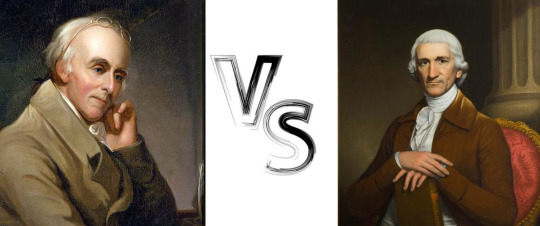
Benjamin Rush (January 4, 1746 [O.S. December 24, 1745] – April 19, 1813) was a Founding Father of the United States who signed the United States Declaration of Independence, and a civic leader in Philadelphia, where he was a physician, politician, social reformer, humanitarian, educator, and the founder of Dickinson College. Rush was a Pennsylvania delegate to the Continental Congress. His later self-description there was: "He aimed right." He served as surgeon general of the Continental Army and became a professor of chemistry, medical theory, and clinical practice at the University of Pennsylvania.
Rush criticized General George Washington in two handwritten but unsigned letters while still serving under the surgeon general. One, to Virginia Governor Patrick Henry dated October 12, 1778, quotes General Thomas Conway saying that if not for God's grace the ongoing war would have been lost by Washington and his weak counselors. Henry forwarded the letter to Washington, despite Rush's request that the criticism be conveyed orally, and Washington recognized the handwriting. Ten days later, Rush wrote to John Adams relaying complaints inside Washington's army, including about "bad bread, no order, universal disgust" and praising Conway, who had been appointed to inspector general.
Charles Thomson (November 29, 1729 – August 16, 1824) was an Irish-born Patriot leader in Philadelphia during the American Revolution and the secretary of the Continental Congress (1774–1789) throughout its existence. As secretary, Thomson, a Founding Father of the United States, prepared the Journals of the Continental Congress, and his and John Hancock's names were the only two to appear on the first printing of the United States Declaration of Independence.
Thomson's service was not without its critics. James Searle, a delegate and close friend of John Adams, began a cane fight on the floor of Congress against Thomson over a claim that he was misquoted in the minutes that resulted in both men being slashed in the face. Such brawls on the floor were common, and many of them were prompted by argument over Thomson's recordings. Political disagreements prevented Thomson from getting a position in the new government created by the U.S. Constitution.
#worst founding father#founding fathers bracket#founding fathers#amrev#brackets#charles thomson#benjamin rush
20 notes
·
View notes
Note
What did John think about Thomas Jefferson?
Not much, if the absence of mentions in his writing is anything to go by.
Of course, that's not very surprising, because Jefferson wasn't Thomas Jefferson yet - not yet as (in)famous and nationally prominent as he became later. By the time of Laurens' death in 1782, Jefferson's most notable achievements were drafting the declaration of independence, and serving as the governor of Virginia.
Laurens was certainly in favour of the declaration, but there is no extant evidence that I have come across of what he thought of the language or principles it contained, nor its author.
Nor have I seen any evidence that they crossed paths during Jefferson's tenure as governor. Laurens would probably have thought that Jefferson fleeing from the British was cowardly, as many did, but he did not write down his opinions on that matter.
On a philosophical level, the two men shared some common enlightenment views on fundamental (male) human freedoms derived from nature, the primacy of individual liberty in any form of government, and meritocracy - for example:
There is also an artificial aristocracy founded on wealth and birth, without either virtue or talents; for with these it would belong to the first class. The natural aristocracy [meritocracy] I consider as the most precious gift of nature for the instruction, the trusts, and government of society. And indeed it would have been inconsistent in creation to have formed man for the social state, and not to have provided virtue and wisdom enough to manage the concerns of the society. May we not even say that that form of government is the best which provides the most effectually for a pure selection of these natural aristoi into the offices of government?
Thomas Jefferson to John Adams, 28 October 1813
if you mean_ as seems more probably from what follows in the Sentence that Ambition is clog’d by the Government, and a Man cannot make a Figure by exerting laudable Talents_ that I must beg leave totally to deny_ under a Republican Government there is the fullest Scope for Ambition directed in it’s proper Channel, in the only Channel in which it ought to be allowed, I mean for the Advancement of Public Good_ [...] surely no virtuous philosophic Mind will take Offence that the useful industrious part of the Community, should have their persons and properties equally protected with those of the most enlighten’d Men_ nor think it unreasonable, that they should choose Men whom they judge worthy of the important Trust of Governing_
John Laurens to Francis Kinloch, 16 June 1776
Simultaneously, Laurens would have considered Jefferson a hypocrite on the subject of slavery.
I'm not that familiar with Jefferson beyond this, so if anyone would like to chip in, or point out any sources I've missed, please feel free.
21 notes
·
View notes
Text
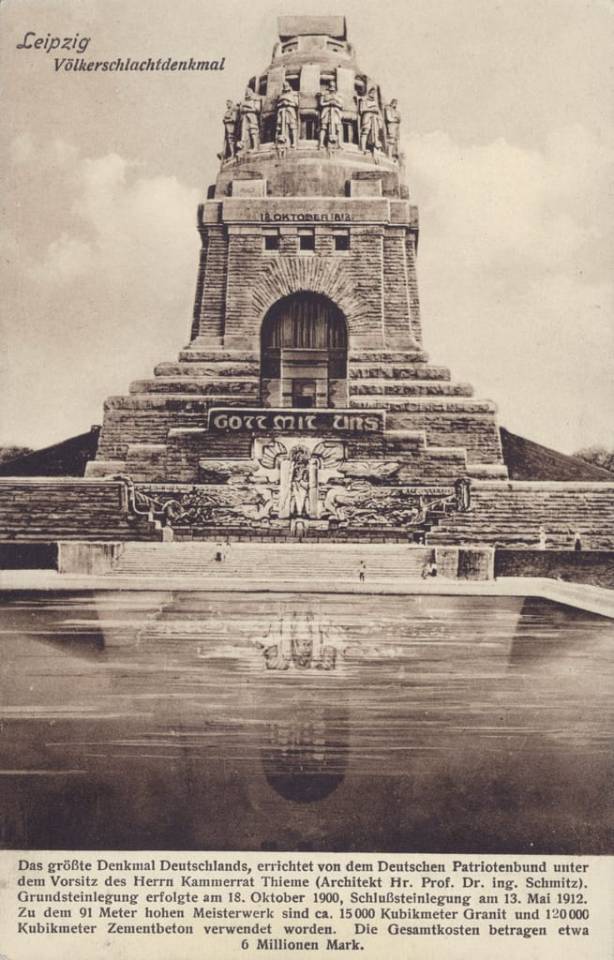
This is the Monument to the Battle of the Nations, located in Leipzig, build in 1913. It has a height of 91 meters and so it is one of the biggest monuments in europe.
In Germany this monument is known as Völkerschlachtdenkmal or (in the vernicular) simply Völki
----
After the disastrous Campaign against Russia in 1812, the Grande Armée was no longer considered invincible. So from 16 to 19 October 1813, Leipzig was the scene of the Battle of the Nations. The allied armies of Russia, Prussia, Austria and Sweden won a decisive victory over Napoleon and his allies. The result: 600,000 soldiers from over twenty nations took part, 100,000 were killed or wounded. Napoleon's Grande Nation collapsed and the Confederation of the Rhine fell apart.
------
I have watched the film NAPOLEON two days ago and I was dissapointed to see that the Battle of the Nations was not mentioned there. With no single word. Neither in the film nor in the statistics at the end.
#the battle of the nations 1813#history#leipzig#Napoleon film 2023#Just one of several reasons why NAPOLEON was not as good as I wished. Hopefully the Director's Cut version will make it better
4 notes
·
View notes
Text
Events 2.7
457 – Leo I becomes the Eastern Roman emperor. 987 – Bardas Phokas the Younger and Bardas Skleros, Byzantine generals of the military elite, begin a wide-scale rebellion against Emperor Basil II. 1301 – Edward of Caernarvon (later king Edward II of England) becomes the first English Prince of Wales. 1313 – King Thihathu founds the Pinya Kingdom as the de jure successor state of the Pagan Kingdom. 1365 – Albert III of Mecklenburg (King Albert of Sweden) grants city rights to Ulvila (Swedish: Ulvsby). 1497 – In Florence, Italy, supporters of Girolamo Savonarola burn cosmetics, art, and books, in a "Bonfire of the vanities". 1756 – Guaraní War: The leader of the Guaraní rebels, Sepé Tiaraju, is killed in a skirmish with Spanish and Portuguese troops. 1783 – American Revolutionary War: French and Spanish forces lift the Great Siege of Gibraltar. 1795 – The 11th Amendment to the United States Constitution is ratified. 1807 – Napoleonic Wars: Napoleon finds Bennigsen's Russian forces taking a stand at Eylau. After bitter fighting, the French take the town, but the Russians resume the battle the next day. 1812 – The strongest in a series of earthquakes strikes New Madrid, Missouri. 1813 – In the action of 7 February 1813 near the Îles de Los, the frigates Aréthuse and Amelia batter each other, but neither can gain the upper hand. 1819 – Sir Thomas Stamford Raffles leaves Singapore after just taking it over, leaving it in the hands of William Farquhar. 1842 – Battle of Debre Tabor: Ras Ali Alula, Regent of the Emperor of Ethiopia defeats warlord Wube Haile Maryam of Semien. 1854 – A law is approved to found the Swiss Federal Institute of Technology. Lectures started October 16, 1855. 1863 – HMS Orpheus sinks off the coast of Auckland, New Zealand, killing 189. 1894 – The Cripple Creek miner's strike, led by the Western Federation of Miners, begins in Cripple Creek, Colorado, United States. 1898 – Dreyfus affair: Émile Zola is brought to trial for libel for publishing J'Accuse…! 1900 – Second Boer War: British troops fail in their third attempt to lift the Siege of Ladysmith. 1900 – A Chinese immigrant in San Francisco falls ill to bubonic plague in the first plague epidemic in the continental United States. 1904 – A fire begins in Baltimore, Maryland;[12] it destroys over 1,500 buildings in 30 hours. 1940 – The second full-length animated Walt Disney film, Pinocchio, premieres. 1943 – World War II: Imperial Japanese Navy forces complete the evacuation of Imperial Japanese Army troops from Guadalcanal during Operation Ke, ending Japanese attempts to retake the island from Allied forces in the Guadalcanal Campaign. 1944 – World War II: In Anzio, Italy, German forces launch a counteroffensive during the Allied Operation Shingle. 1951 – Korean War: More than 700 suspected communist sympathizers are massacred by South Korean forces. 1962 – The United States bans all Cuban imports and exports. 1974 – Grenada gains independence from the United Kingdom. 1979 – Pluto moves inside Neptune's orbit for the first time since either was discovered. 1984 – Space Shuttle program: STS-41-B Mission: Astronauts Bruce McCandless II and Robert L. Stewart make the first untethered space walk using the Manned Maneuvering Unit (MMU). 1986 – Twenty-eight years of one-family rule end in Haiti, when President Jean-Claude Duvalier flees the Caribbean nation. 1990 – Dissolution of the Soviet Union: The Central Committee of the Soviet Communist Party agrees to give up its monopoly on power. 1991 – Haiti's first democratically elected president, Jean-Bertrand Aristide, is sworn in. 1991 – The Troubles: The Provisional IRA launches a mortar attack on 10 Downing Street in London, the headquarters of the British government. 1992 – The Maastricht Treaty is signed, leading to the creation of the European Union. 1995 – Ramzi Yousef, the mastermind of the 1993 World Trade Center bombing, is arrested in Islamabad, Pakistan. 1999 – Crown Prince Abdullah becomes the King of Jordan on the death of his father, King Hussein. 2001 – Space Shuttle program: Space Shuttle Atlantis is launched on mission STS-98, carrying the Destiny laboratory module to the International Space Station. 2009 – Bushfires in Victoria leave 173 dead in the worst natural disaster in Australia's history. 2012 – President Mohamed Nasheed of the Republic of Maldives resigns, after 23 days of anti-governmental protests calling for the release of the Chief Judge unlawfully arrested by the military. 2013 – The U.S. state of Mississippi officially certifies the Thirteenth Amendment, becoming the last state to approve the abolition of slavery. The Thirteenth Amendment was formally ratified by Mississippi in 1995. 2014 – Scientists announce that the Happisburgh footprints in Norfolk, England, date back to more than 800,000 years ago, making them the oldest known hominid footprints outside Africa. 2016 – North Korea launches Kwangmyŏngsŏng-4 into outer space violating multiple UN treaties and prompting condemnation from around the world. 2021 – The 2021 Uttarakhand flood begins.
1 note
·
View note
Text
OCTOBER 16TH
October 16 might just be one of the most action-packed dates in history!
Back in 1813, Napoleon faced a crushing defeat at the Battle of Leipzig, the largest European battle before World War I, as Prussia, Austria, and Russia joined forces to bring down his empire.
On this day in 1925, the Locarno Treaties were concluded to secure peace in post-World War I Europe, aiming to prevent another devastating conflict.
In 1934, Mao Zedong and 25,000 of his followers began the legendary Long March, a grueling 6,000-mile journey that reshaped China's destiny.
Then, in 1964, China entered the nuclear age by successfully detonating its first atomic bomb, shaking up global power dynamics.
And in 1978, Karol Józef Wojtyła became Pope John Paul II, the first non-Italian pope in 455 years, bringing fresh perspectives to the Catholic Church.
October 16 continues to echo through time as a date of monumental shifts!
youtube
1 note
·
View note
Text

María de la Encarnación Ezcurra (March 25, 1795 – October 20, 1838) was an Argentine political activist, wife of Juan Manuel de Rosas.
She was the daughter of Juan Ignacio Ezcurra and Teodora de Arguibel. She married Rosas on March 16, 1813. She became her husband's most faithful follower, helping him in many difficult circumstances. In 1833–1834, her husband was away from Buenos Aires leading an army in the Desert Campaign to extend Argentina's frontier. She was the driving force behind the Revolution of the Restorers, and was the president of the Mazorca, an organization which acted as a secret police. The Revolution of the Restorers unseated Juan Ramón Balcarce the governor of the Buenos Aires. The Mazorca put pressure on every government worker to vocally campaign for the return of de Rosas. This forced the provincial legislature, the Board of Representatives, which had the power to designate governors, to regard her husband as the only option to restore social order in the province.
After the triumph of her husband in the Desert Campaign (1833–34), and with her success in securing the governorship for him, the people gave her the title of Heroine of the Holy Federation. It is particularly notable that at that time prejudices against women participating in politics ran high, yet Ezcurra achieved great responsibilities and a considerable following.
She died unexpectedly at the age of 43. Even today historians dispute the cause of her death although many believe that she died of cardiac arrest or a similar condition. Her death, however, caused great grief among the people and the political establishment. Twenty five thousand participated in her funeral procession from el Fuerte to the Convent of San Francisco, where she was buried. That would have represented 40% of the total population living in Buenos Aires at the time. The funeral costs were paid for by the Board of Representatives, whom Rosas formally thanked on November 1, 1838.
#Encarnación Ezcurra#Heroine of the Holy Federation#women in activism#women in history#women in politic#women of the revolution
0 notes
Text




















The Sixth Coalition attacked Napoleon in the three-day Battle of Leipzig on October 16, 1813.
#Sixth Coalition#attacked#Napoleon#Battle of Leipzig#16 October 1813#110th anniversary#history#Völkerschlachtdenkmal#Bruno Schmitz#Germany#Leipzig#Monument to the Battle of the Nations#tourist attraction#landmark#summer 2020#Saxony#Sachsen#archangel#Michael#original photography#vacation#travel#Deutschland#See der Tränen#pond#reflection#evening light
2 notes
·
View notes
Text
IEEE Transactions on Cognitive and Developmental Systems, Volume 16, Issue 5, October 2024
1) Guest Editorial: Special Issue on Advancing Machine Intelligence With Neuromorphic Computing
Author(s): Guoqi Li, Emre Neftci, Rong Xiao, Pablo Lanillos, Kaushik Roy
Pages: 1623 - 1625
2) LC-TTFS: Toward Lossless Network Conversion for Spiking Neural Networks With TTFS Coding
Author(s): Qu Yang, Malu Zhang, Jibin Wu, Kay Chen Tan, Haizhou Li
Pages: 1626 - 1639
3) Asymmetric Spatiotemporal Online Learning for Deep Spiking Neural Networks
Author(s): Rong Xiao, Limiao Ning, Yixuan Wang, Huajun Du, Sen Wang, Rui Yan
Pages: 1640 - 1647
4) Unlocking the Potential of Spiking Neural Networks: Understanding the What, Why, and Where
Author(s): Buddhi Wickramasinghe, Sayeed Shafayet Chowdhury, Adarsh Kumar Kosta, Wachirawit Ponghiran, Kaushik Roy
Pages: 1648 - 1663
5) SIBoLS: Robust and Energy-Efficient Learning for Spike-Based Machine Intelligence in Information Bottleneck Framework
Author(s): Shuangming Yang, Haowen Wang, Badong Chen
Pages: 1664 - 1676
6) Closed-Form Control With Spike Coding Networks
Author(s): Filip S. Slijkhuis, Sander W. Keemink, Pablo Lanillos
Pages: 1677 - 1687
7) Improving Graph Collaborative Filtering via Spike Signal Embedding Perturbation
Author(s): Ying Ma, Gang Chen, Guoqi Li
Pages: 1688 - 1697
8) EEG-Based Auditory Attention Detection With Spiking Graph Convolutional Network
Author(s): Siqi Cai, Ran Zhang, Malu Zhang, Jibin Wu, Haizhou Li
Pages: 1698 - 1706
9) Brain-Inspired Model and Neuromorphic Circuit Implementation for Feature-Affective Associative Memory Network
Author(s): Yutong Zhang, Zhigang Zeng
Pages: 1707 - 1721
10) Memristive Circuit Design for Personalized Emotion Generation With Memory and Retrieval Functions
Author(s): Zhanfei Chen, Xiaoping Wang, Chao Yang, Zilu Wang, Zhigang Zeng
Pages: 1722 - 1735
11) BitSNNs: Revisiting Energy-Efficient Spiking Neural Networks
Author(s): Yangfan Hu, Qian Zheng, Gang Pan
Pages: 1736 - 1747
12) Measuring Human Comfort in Human–Robot Collaboration via Wearable Sensing
Author(s): Yuchen Yan, Haotian Su, Yunyi Jia
Pages: 1748 - 1758
13) Deep-Reinforcement-Learning-Based Driving Policy at Intersections Utilizing Lane Graph Networks
Author(s): Yuqi Liu, Qichao Zhang, Yinfeng Gao, Dongbin Zhao
Pages: 1759 - 1774
14) DatUS: Data-Driven Unsupervised Semantic Segmentation With Pretrained Self-Supervised Vision Transformer
Author(s): Sonal Kumar, Arijit Sur, Rashmi Dutta Baruah
Pages: 1775 - 1788
15) Efficient Semisupervised Object Segmentation for Long-Term Videos Using Adaptive Memory Network
Author(s): Shan Zhong, Guoqiang Li, Wenhao Ying, Fuzhou Zhao, Gengsheng Xie, Shengrong Gong
Pages: 1789 - 1802
16) Deep Learning to Interpret Autism Spectrum Disorder Behind the Camera
Author(s): Shi Chen, Ming Jiang, Qi Zhao
Pages: 1803 - 1813
17) Spatiotemporal Feature Enhancement Network for Blur Robust Underwater Object Detection
Author(s): Hao Zhou, Lu Qi, Hai Huang, Xu Yang, Jing Yang
Pages: 1814 - 1828
18) GENet: A Generic Neural Network for Detecting Various Neurological Disorders From EEG
Author(s): Md. Nurul Ahad Tawhid, Siuly Siuly, Kate Wang, Hua Wang
Pages: 1829 - 1842
19) Toward Two-Stream Foveation-Based Active Vision Learning
Author(s): Timur Ibrayev, Amitangshu Mukherjee, Sai Aparna Aketi, Kaushik Roy
Pages: 1843 - 1860
20) Unifying Obstacle Avoidance and Tracking Control of Redundant Manipulators Subject to Joint Constraints: A New Data-Driven Scheme
Author(s): Peng Yu, Ning Tan, Zhaohui Zhong, Cong Hu, Binbin Qiu, Changsheng Li
Pages: 1861 - 1871
21) Cognitive Assessment of Scientific Creative Skill by Brain-Connectivity Analysis Using Graph Convolutional Interval Type-2 Fuzzy Network
Author(s): Sayantani Ghosh, Amit Konar, Atulya K. Nagar
Pages: 1872 - 1886
22) MAVIDSQL: A Model-Agnostic Visualization for Interpretation and Diagnosis of Text-to-SQL Tasks
Author(s): Jingwei Tang, Guodao Sun, Jiahui Chen, Gefei Zhang, Baofeng Chang, Haixia Wang, Ronghua Liang
Pages: 1887 - 1903
0 notes
Text
Nelson’s signal at Trafalgar
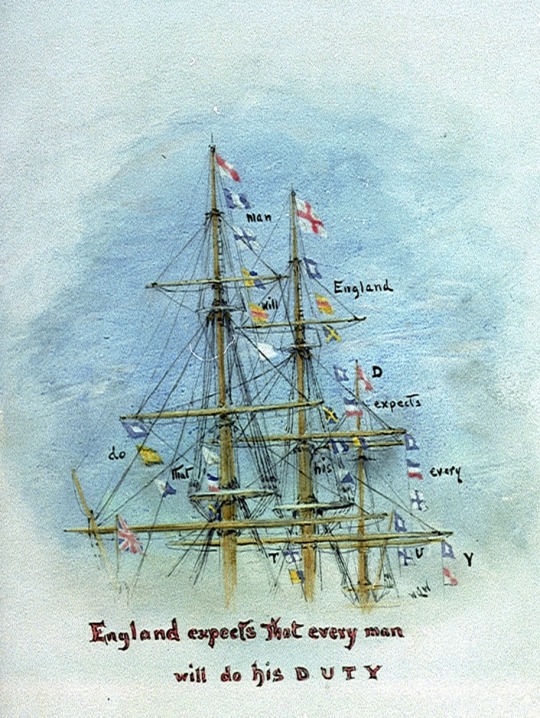
The first edition of Popham’s Telegraphic Signals or Marine Vocabulary was printed in 1800; a more comprehensive version was produced in 1803, and a further much expanded edition using letters as well as numbers in 1812. This was issued to the navy in 1813, and from that time, vocabulary signals were part of the official flag signalling code of the Royal Navy.
Nelson’s signal to the fleet before the beginning of the Battle of Trafalgar on 21 October 1805 read ENGLAND EXPECTS THAT EVERY MAN WILL DO HIS DUTY and was made in Popham’s vocabulary, using the numerical flags of the general Signal Book as re-arranged in 1803. The signals officer of the Victory at the time was Lieutenant John Pasco, who gave, many years later, this account of the incident:
His Lordship came to me on the poop, and after ordering certain signals to be made, about a quarter to noon, he said, ‘Mr Pasco, I wish to say to the fleet, “England confides that every man will do his duty”’, and he added, ‘you must be quick for I have one more to make, which is Close Action’. I replied, ‘if your Lordship will permit me to substitute the “expects” for “confides”, the signal will soon be completed, because the word “expects” is in the vocabulary, and “confides” must be spelt.’ His Lordship replied in haste, and with seeming satisfaction, ‘That will do, Pasco, make it directly’; when it had been answered by a few ships in the van, he ordered me to make the signal for Close Action and to keep it up, accordingly I hoisted No. 16 at the top-gallant mast-head and there it remained until shot away.
— Timothy Wilson, Flags at Sea
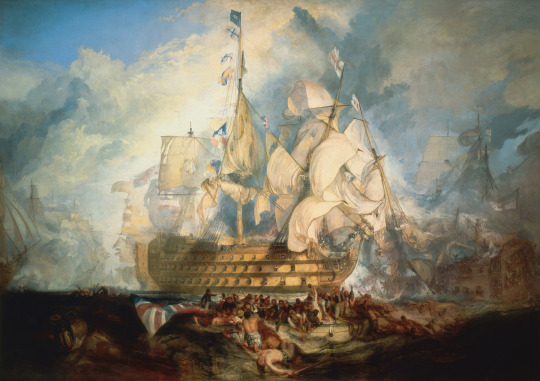
In J.M.W. Turner's 1822 painting, The Battle of Trafalgar, 21 October 1805, part of the word DUTY may be seen in the visible signal flags of HMS Victory.
#age of sail#battle of trafalgar#horatio nelson#trafalgar day#naval history#royal navy#napoleonic wars#hms victory#maritime signal flags#age of fighting sail#military history#flags at sea#nelson's signal#joseph mallord william turner#timothy wilson#naval art#england expects that every man will do his duty
166 notes
·
View notes
Photo

Battle of Leipzig
The Battle of Leipzig (16-19 October 1813), or the Battle of the Nations, was the largest battle of the Napoleonic Wars (1803-1815), featuring over half a million soldiers and resulting in over 100,000 total casualties. The climax of the 1813 German campaign, the battle ended with the decisive defeat of French Emperor Napoleon I (r. 1804-1814; 1815).
Continue reading...
43 notes
·
View notes
Photo

“ Das Reitergefecht bei Liebertwolkwitz am 14. Oktober 1813. Im Vordergrund Marschall Murat” by Richard Knötel
The cavalry battle at Liebertwolkwitz on October 14, 1813, in the foreground Marshal Murat
Crude google translation from the website linked below:
Duel with the King (Murat)
In the run-up to the Battle of Leipzig, on October 14, 1813, there was a cavalry battle between the cavalry corps of the Russian General Count von der Pahlen and the cavalry of the French Marshal and King of Naples, Murat. Since the battle, which lasted from 9 a.m. to 6 p.m., involved up to 15,000 horsemen from both sides in the melee, the battle is often called the "biggest cavalry battle of modern times".The Pahlen Cavalry Corps also included the Prussian Mounted Grenadier Regiment "Freiherr von Derfflinger" (Neumarkisches) No. 3, founded in 1807 in Bromberg. In association with two Russian hussar regiments, it encountered the French positions south of Leipzig in the course of a violent reconnaissance. In the wide plain between Dölitz, Markkleeberg, Wachau, Liebertwolkwitz and Holzhausen, Marshal Murat had his French, Poles and Rheinbündische entrenched in accordance with a plan by Marshal Victor.
Pahlen, who was only a moderately talented general, did not recognize this locking position and ordered the attack from the movement. The Allies quickly came under heavy French artillery fire from the Galgenberg, the dominant height in this flat country. The order "Collect backwards" had to be given while the French cavalry counterattacked. As always, Marshal Murat himself rode at the head in his theatrical costume.
Lieutenant Guido von der Lippe commanded the flanking platoon in the 2nd Squadron of Mounted Grenadiers. The young Upper Silesian made the decision to capture this "vain peacock". He used the moment, when the King of Naples was only accompanied by his body boy ( Leibbursche ), to make an unauthorized advance, accompanied by a few comrades from his cavalcade.
With the call "Halt, König, halt!", spoken in German, the lieutenant tried to grasp the reins of Murat's white palfrey. He dodged it skillfully and stared blankly at the young officer, drawn saber in hand. The body boy, on the other hand, reacted with lightning speed and knocked the attacker out of the saddle with his edged weapon. However, the approaching body squadron of the king put an end to the bold attempt at capture by the Neumärker.
Lieutenant Guido von der Lippe was found by his lad on the battlefield on October 16, 1813, hidden under corpses, and buried with honor by the 2nd squadron. The history painter Richard Knötel later created a lasting monument to him.
Murat's body boy was appointed "Royal Equerry", an "honorary pension from the city of Naples" for life and the horse of the lieutenant von der Lippe. Emperor Napoleon awarded the equerry the "Cross of the Legion of Honour".
Source: "The book of facts of the German cavalry." Dedicated to the German cavalry by Emil Buxbaum, Major on the staff of the kb 2nd Heavy Cavalry Regiment "Archduke Franz Ferdinand von Austria-Este", Berlin and Leipzig, Verlag Friedrich Luckhardt, 1900.
Link
23 notes
·
View notes